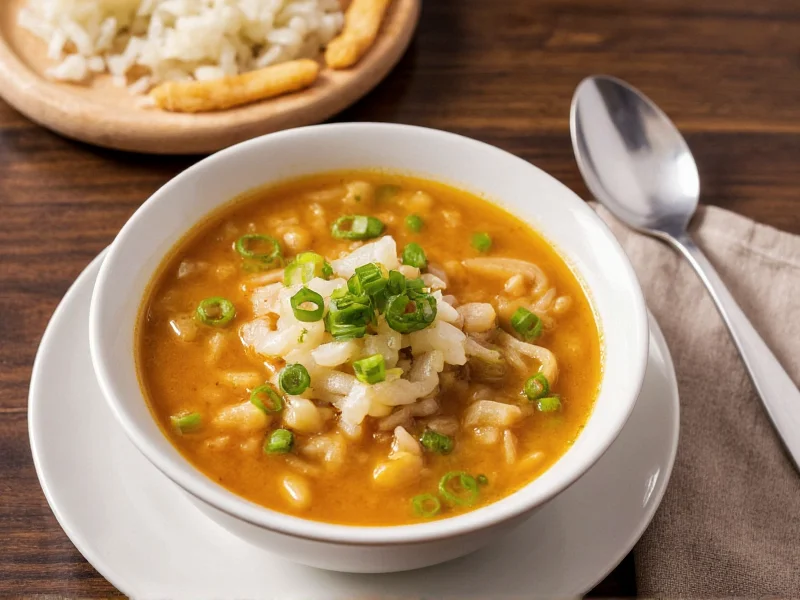The Essential Components of Perfect Rice Onion Soup
Creating exceptional rice onion soup requires understanding how each element contributes to the final dish. Unlike French onion soup that relies on cheese-topped bread, this simpler version uses rice as both ingredient and thickener. The magic happens when starch from the rice combines with the onion's natural sugars during simmering, creating a velvety texture without dairy.
Core Ingredients and Their Functions
Quality ingredients make the difference between ordinary and outstanding soup. Yellow onions provide the ideal balance of sweetness and sharpness, while long-grain rice like basmati maintains structure during cooking. The broth choice significantly impacts flavor depth—homemade vegetable or chicken stock elevates simple ingredients into something remarkable.
| Ingredient | Recommended Quantity | Function in Soup |
|---|---|---|
| Yellow onions | 3 large (about 1.5 lbs) | Primary flavor base, caramelizes to sweet richness |
| Long-grain rice | 1/2 cup uncooked | Thickener and texture component |
| Homemade broth | 4 cups | Flavor foundation and cooking liquid |
| Fresh thyme | 2 sprigs | Aromatic complexity |
| Olive oil | 2 tablespoons | Medium for caramelization |
Step-by-Step Preparation Method
Mastering rice onion soup requires attention to the caramelization process. Begin by thinly slicing onions evenly—this ensures uniform cooking. Cook them slowly over medium-low heat for 25-30 minutes, stirring occasionally, until they reach a deep golden brown. Rushing this step creates bitter flavors instead of the desired sweet complexity. When onions have fully caramelized, add the rice and toast for 2 minutes before pouring in warmed broth.
The simmering phase determines your soup's final texture. Maintain a gentle bubble for 20-25 minutes until rice has broken down sufficiently to thicken the broth while remaining discernible. For a creamier texture without dairy, blend half the soup then return it to the pot. This technique creates body while preserving some whole rice grains for textural interest.
Avoiding Common Preparation Mistakes
Many home cooks encounter issues with rice onion soup due to three frequent errors. First, using quick-cooking rice varieties that disintegrate too quickly creates a gluey consistency. Second, adding cold broth to hot onions causes temperature shock that stops caramelization. Always warm your broth before adding. Third, over-seasoning early in the process—wait until the end to adjust salt levels since reduction concentrates flavors.
Adapting Your Rice Onion Soup
This basic recipe serves as a canvas for numerous variations. For a protein boost, stir in shredded chicken during the last five minutes of cooking. Vegetarian versions shine with the addition of diced carrots and celery during the initial sauté. Those seeking richer flavor can finish with a tablespoon of butter or a Parmesan rind simmered with the broth. The gluten-free rice onion soup preparation requires only ensuring your broth contains no wheat-based ingredients.
Serving and Storage Recommendations
Serve rice onion soup immediately for best texture, as continued sitting causes rice to absorb more liquid. If leftovers remain, store in airtight containers for up to four days. When reheating, add splashes of broth or water to restore proper consistency since rice continues absorbing liquid during storage. Freezing works well for up to three months—thaw overnight in the refrigerator before reheating gently.
Frequently Asked Questions
What type of rice works best for rice onion soup?
Long-grain varieties like basmati or jasmine maintain their structure longer during simmering while still releasing enough starch to thicken the soup. Avoid instant or quick-cooking rice, which breaks down too rapidly and creates a gummy texture. About 1/2 cup uncooked rice typically suffices for a standard four-serving batch.
How can I prevent my rice from becoming mushy in onion soup?
Add the rice after onions have caramelized and toast it for 2 minutes before adding warmed broth. Maintain a gentle simmer rather than a rolling boil, and remove from heat when rice is just tender but still slightly firm. The residual heat will continue cooking the rice. For best results with easy weeknight rice onion soup preparation, set a timer for 20 minutes of simmering.
Can I make rice onion soup without broth?
Yes, though broth provides essential depth. For a simpler version, use water with 2 tablespoons of soy sauce or miso paste for umami. The natural sweetness from properly caramelized onions carries the flavor, but broth-free versions benefit from an extra bay leaf and longer simmering to develop complexity in this healthy rice onion soup variation.
How long does rice onion soup keep in the refrigerator?
Properly stored in airtight containers, rice onion soup maintains quality for 3-4 days. The rice continues absorbing liquid during storage, so you'll need to add splashes of water or broth when reheating. For longer preservation, freeze portions for up to three months—thaw overnight before reheating gently to maintain the best texture for your rice onion soup storage.
What are traditional accompaniments for rice onion soup?
This simple rice onion soup pairs beautifully with crusty bread for dipping. For a complete meal, serve alongside a green salad or roasted vegetables. In French-inspired variations, a small grating of Parmesan adds savory depth without overpowering the delicate onion flavor. The soup's mild profile makes it an excellent starter before heartier main courses.











 浙公网安备
33010002000092号
浙公网安备
33010002000092号 浙B2-20120091-4
浙B2-20120091-4